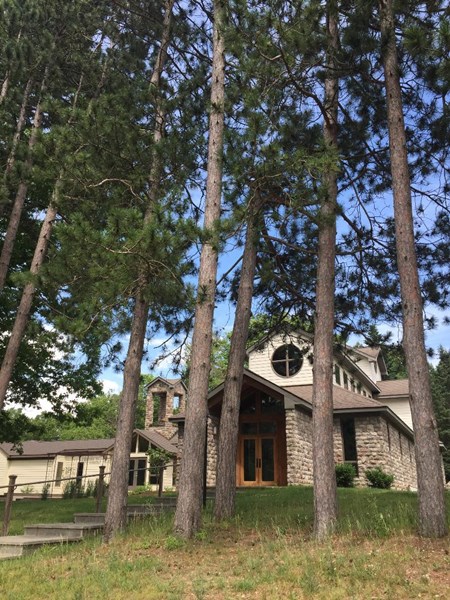Monastic Musings Part III
Jun 27, 2018
“What, a Lutheran Monastery?”
Monastic Musings 2018 (Part III)
By the Rev. Jonathan Linman
Assistant to the Bishop for Faith and Leadership Formation

I write to you from St. Augustine’s House, Congregation of the Servants of Christ, a Lutheran Benedictine Monastery in the woods 40 miles north of Detroit, Michigan. “What,” you may remark with some mild incredulity, “a Lutheran monastery? I thought Luther rejected monasticism and left all of that behind him.”

Reformation historian, Professor Timothy Wengert, has convinced me that it is not so much that Luther rejected monasticism, but that he wished to bring deep, engaged Christian faith life to all of God’s people such that robust spirituality was not just the domain of religious professionals, that is, the monks and nuns. The monastic practice of Luther’s day deviated greatly from the intent of the founders of religious orders, just as the whole Church at the time was in need of reform. Hence, Luther’s criticisms of monasticism and the ways in which monastic practices clouded or corrupted the gospel message.
So, unlikely as it may seem, here I am at a Lutheran monastery, where I have been an associate member since the early 1990’s, having been drawn to the spirit of the Benedictine way early in my ordained ministry. I was invited to my first retreat here by Fr. John Cochran, my principal mentor in inner-city ministry, who is now Prior of the monastery in his retirement from parish ministry. For him, ministry is a healthy blend of contemplation and social action. It’s good to be back here, and it’s been a long time. Until now, I had made only one visit during the 17 years that I’ve lived in New York City. But this place continues to beckon me.
St. Augustine’s House was founded in 1958 by Father Arthur Kreinheder, an American, but ordained as a priest in the Church of Sweden, who was sent by the Swedish Church as a missionary in the United States. His mission work ended up focusing on establishing this monastic community, which has been small throughout its history – only a handful of professed members at any given time – but which has a goodly number of associate members throughout the United States, and many more friends in the Fellowship of St. Augustine (click here if you want to learn more: http://www.staugustineshouse.org/). The Congregation of the Servants of Christ is a sister community to a Lutheran monastery in Sweden and enjoys friendships with other religious orders in a devoted ecumenical spirit. Monastic communities of various Christian traditions share a common bond in adherence to the Rule of St. Benedict.

If you’ve read other installments of my sabbatical monastic musings, you know that I am exploring in reading and experience the intersections between Benedictine spirituality and ministry and life in the non-cloistered world in which most of us live. As I continue to do my reading of commentaries on the Rule of St. Benedict written by various authors, lay and professed, and as I live daily the Benedictine way, it strikes me that there is significant congruence between Benedictine spirituality and the Lutheran theological and spiritual ethos.
I will develop all of this further for presentations that I will make in the context of a Benedictine Spirituality retreat I plan to host for leaders of our Synod early in 2019, but what follows are significant points of congruence between the Benedictine and Lutheran ways – think of these as sub-headings for a fuller presentation, and teasers to get you thinking about Benedictine Lutheranism. Both the Lutheran and Benedictine traditions embrace, proclaim, and seek to live the following tenets:
- The centrality of Christ alone, the gospel, and the cross
- Growth in grace and faith alone through God’s all-embracing love
- Scripture alone, and the centrality of reading and study in spiritual life
- Living creatively the paradoxes and tensions of life and faith
- A pastoral, realistic, earthy, flexibly ordered Christian life
- Intentionality in nurturing community life
- Vocation for all and the holiness of work
- The centrality of humility, and the holiness of ordinary things and routines
- Radical hospitality with eyes focused on the world
- And when it’s all said and done, God alone gets the glory
It strikes me that Lutherans typically and historically have spent so much time focusing on heralding the teaching and proclamation of justification by grace effective through faith, that we have not fully developed the implications of God’s justification of us sinners for how we practically live the gospel in our day-to-day routines. This is where the Rule of St. Benedict and Benedictine spirituality are great gifts to Lutherans. For the Benedictine way gives us a gentle, adaptable, holistic, and an all-of-life-encompassing set of principles and practical “how to” tips for living the gospel of God’s radical grace 24/7. In other words, the Benedictine way guides us in how to be disciples of Jesus in all that we do – not just on Sunday mornings.
As I write, it’s the commemoration day of the Presentation of the Augsburg Confession in 1530 – a perfect time to explore intersections between Lutheranism and Benedictine Spirituality in a Lutheran monastery. By the time that you read this, my monastic adventures will be drawing to a close. Please know that I continue to keep you and our synodical life together in my prayers each and every day.